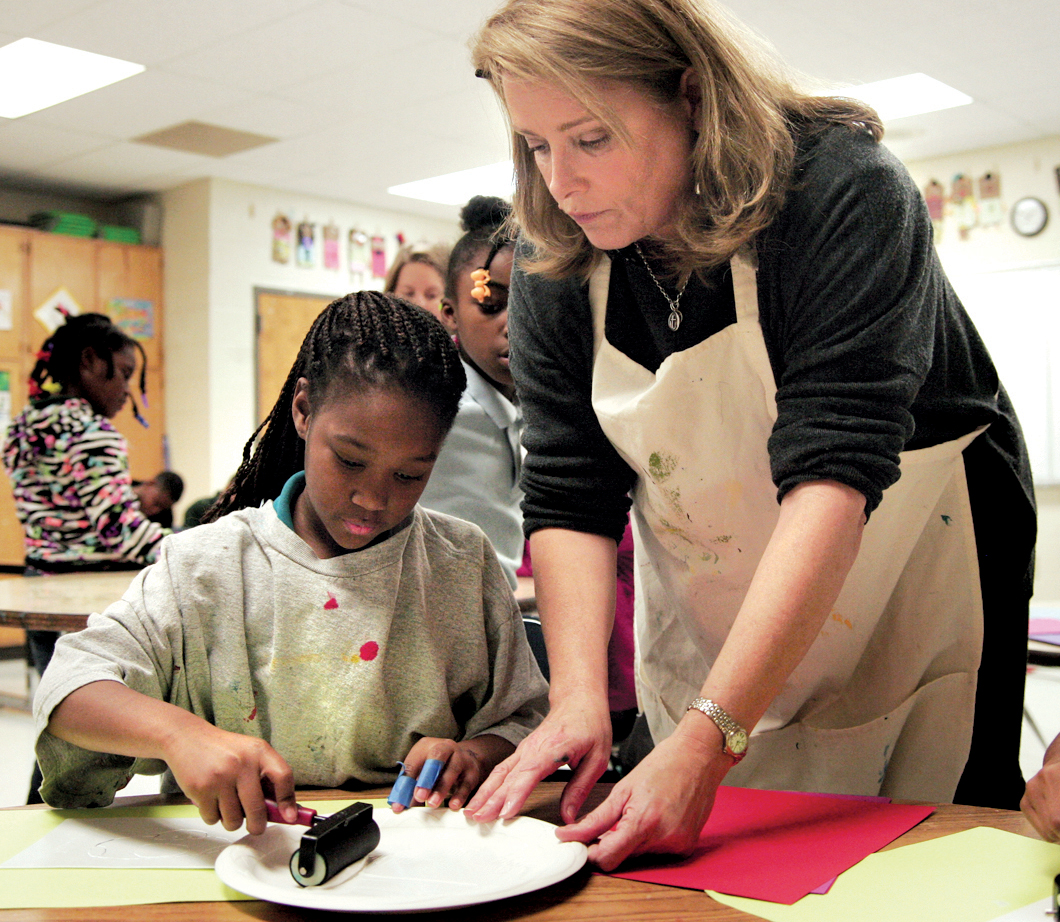 Susanne Bowling, a volunteer art teacher at Calvin Donaldson Environmental Science Academy, helps third-grader Domonique Woods run a brayer through ink to make a pop art-inspired print. Bowling teaches at Calvin Donaldson about three days a week to help compensate for the lack of a school-funded art class.
Susanne Bowling, a volunteer art teacher at Calvin Donaldson Environmental Science Academy, helps third-grader Domonique Woods run a brayer through ink to make a pop art-inspired print. Bowling teaches at Calvin Donaldson about three days a week to help compensate for the lack of a school-funded art class.It's no Campbell's soup, but the Andy Warhol-inspired art at Calvin Donaldson Elementary is more sophisticated work than you might expect from third-graders.
To create their own prints, students swap the soup for more contemporary icons -- SpongeBob SquarePants, Xbox controllers and McDonald's french fry containers. With the famous works of Monet, Matisse and VanGogh surrounding them, students carefully engrave their images into Styrofoam and roll squishy ink over the surface.
They protect their uniforms with oversized T-shirts-turned-smocks and press the ink onto four different colored sheets of paper to create their own version of pop art. Warhol is just one of many classic and modern artists that Calvin Donaldson students know well, thanks to their art classes, which incorporate everything from history to math.
"It does not take away from instruction," said Principal Becky Coleman. "It adds to instruction."
But this classroom and its teachers operate with virtually no taxpayer money.
The supplies are paid for through private donations, and the two teachers volunteer their time several days each week. Rather than lamenting the lack of arts in county elementary schools, Susanne Bowling and Gayle Ligon decided to jump in and get their hands dirty.
And with only 13 of 44 elementary schools staffed with an art teacher, Calvin Donaldson students are lucky to get any art instruction at all. On the other hand, music has a presence in every elementary school.
Bowling, who works full time running an art academy at Chattanooga Christian School, likens education without art to feeding students only meat and no vegetables.
"We really believe art is part of a child's complete diet," she said.
"That's my dream: to have an art teacher in every elementary school," said Karla Riddle, who oversees fine arts, among other duties, at the central office.
She hopes to reach the dream before she retires in June. But the challenge is immense.
Officials estimate it would cost $2 million to $3 million a year to hire the extra teachers. Superintendent Rick Smith said he supports the idea of adding more art teachers, but isn't sure where the money would come from. And with school security and technology upgrades at the forefront now, it's unclear whether art will be made a top priority come budget season this spring.
In addition to fostering creativity, research shows a connection between the arts and student achievement, Riddle said.
"We keep hearing businesses talking all the time about how we need creative, innovative people," she said. "This is something that fosters those skills."
Third-grader JaMaal Macon has an equally enthusiastic, though less refined, view of art class.
"I love art. It's the only time I can think and imagine," he said.
And if students like JaMaal weren't given access to art at an early age, they'd enter middle or high school art classes without fundamental skills. Without the basics, art proponents say Hamilton County is making it difficult for its students to go on to careers in art, design and architecture.
"It's like you walk into middle school and take math classes without knowing how to add or subtract," said Rodney Van Valkenburg, director of grants and initiatives at ArtsBuild, a Chattanooga nonprofit arts fund and arts council.
ArtsBuild, formerly known as Allied Arts, used to fund individual school grants to promote the arts. But the group has broadened its giving so all Hamilton County students can experience the arts -- it pays for all second-graders to attend the "Nutcracker" and all third-graders to visit the symphony, among other experiences.
Valkenburg said ArtsBuild may try to help raise money to help pay for more elementary art teachers on a temporary basis. But that's not a permanent solution, and he doesn't believe private groups or parents should have to fund salaries in the long term.
It's more important to build a demand for art, he said.
Elementary schools that do have a visual arts teacher must pay for it through PTAs, foundations or special federal funds. To fix the disparity, Valkenburg says parents should call for equal access to art education.
"I think parents have a lot of sway and can help make that happen," he said.
